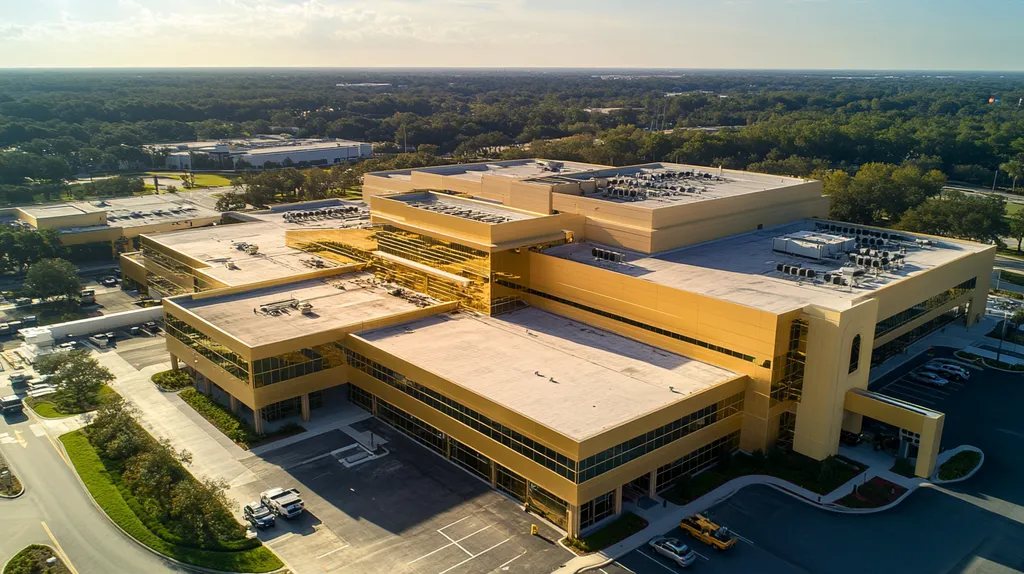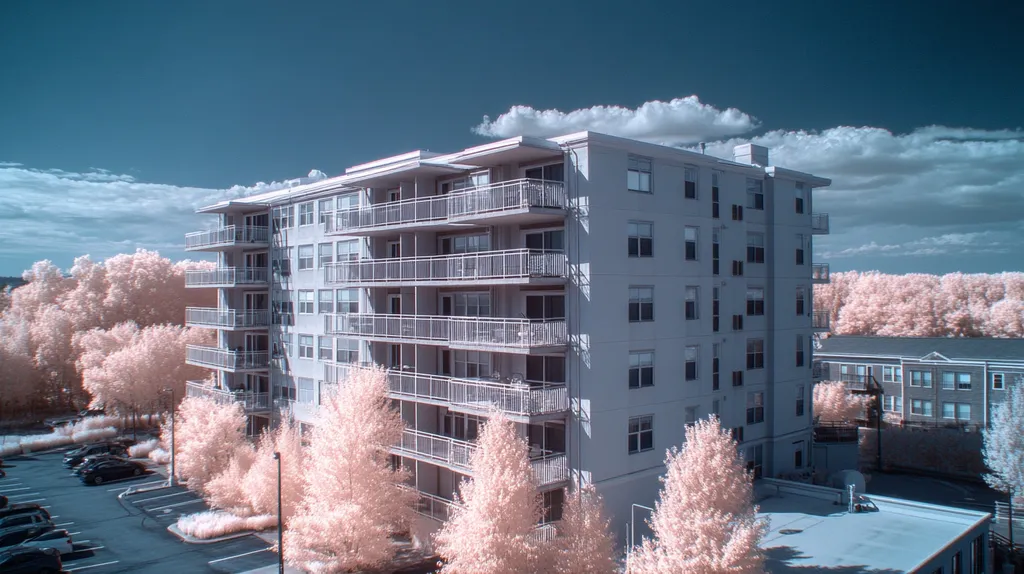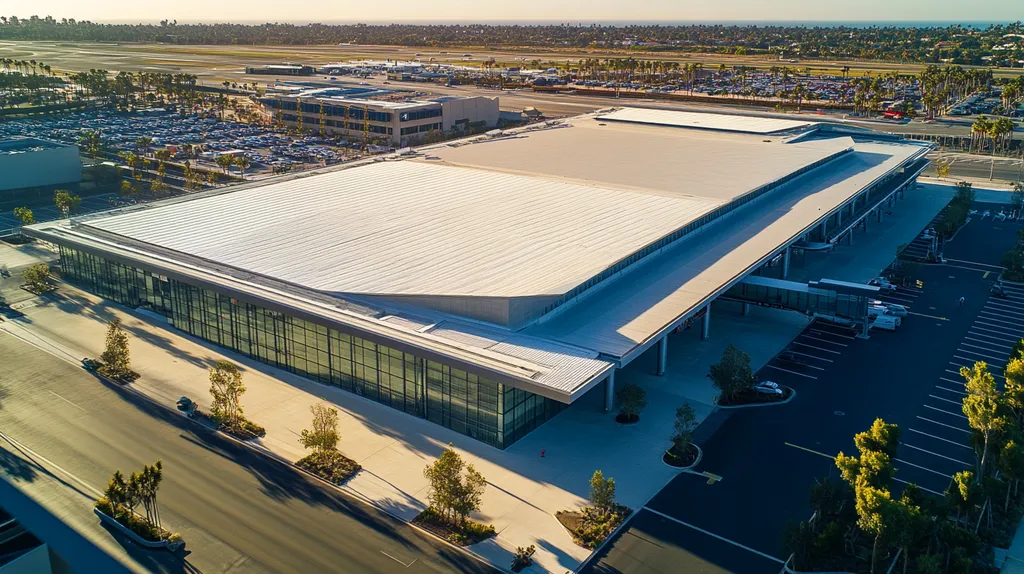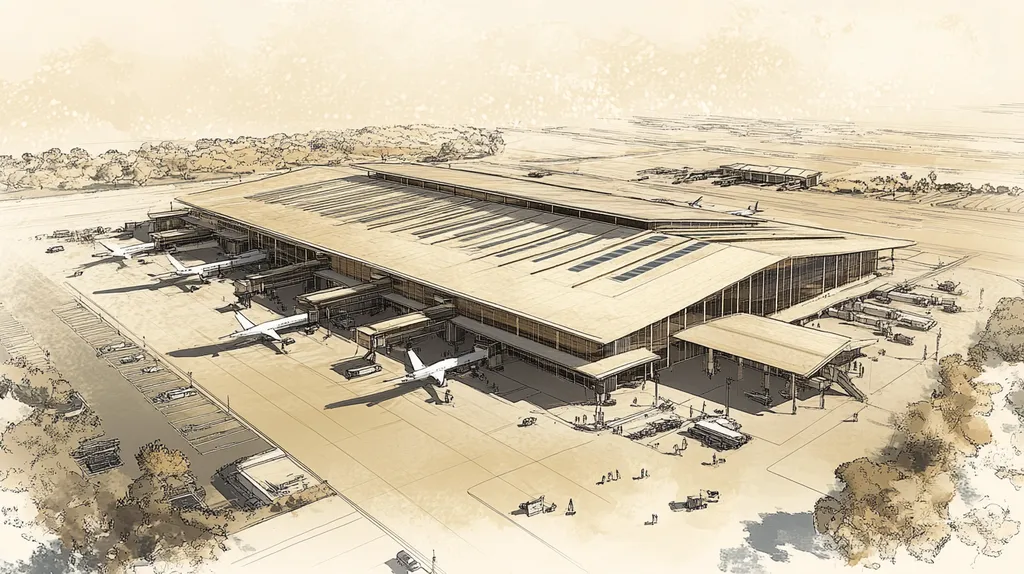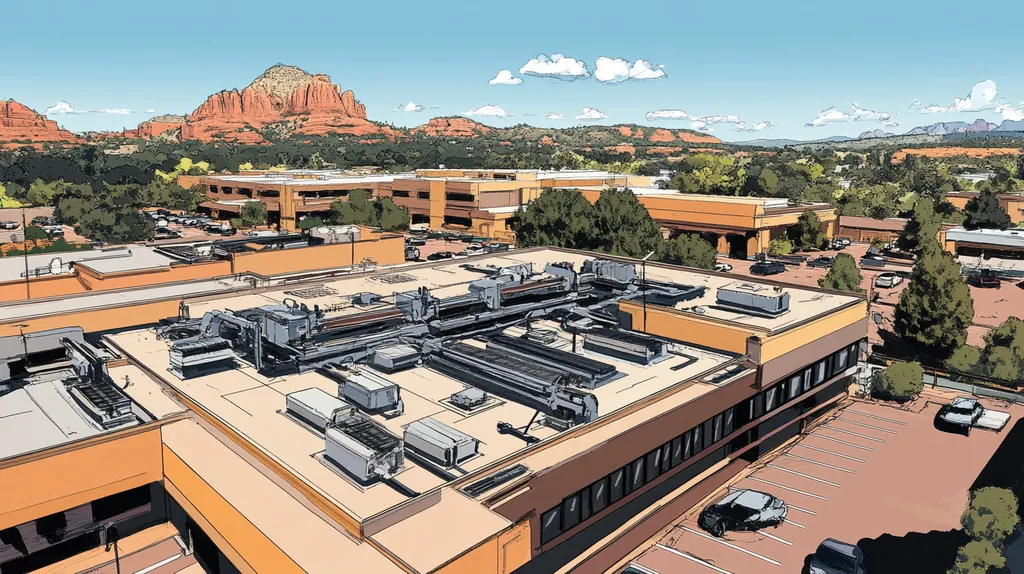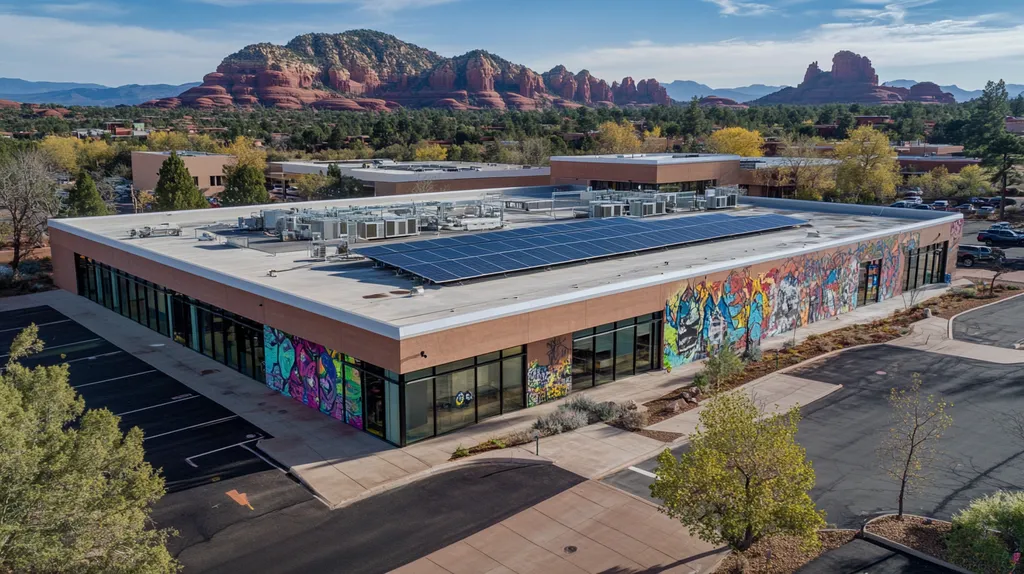Climate change is forcing commercial property owners to radically rethink their approach to roof maintenance, with 40% of commercial roofs now failing prematurely due to extreme weather conditions they weren’t designed to handle.
Understanding how different climate zones impact roofing systems has become essential for protecting these vital assets, which often represent up to 10% of total building costs.
This comprehensive guide examines how regional weather patterns affect roof durability, maintenance requirements, and long-term performance, providing property managers with actionable strategies for extending roof life and reducing repair costs across diverse climate conditions.
SECTION 1: FUNDAMENTAL CONCEPTS
Climate change is reshaping the landscape of commercial roofing, making it a pressing concern for property owners and facility managers. Extreme weather events are on the rise, according to the National Oceanic and Atmospheric Administration (NOAA), leading to urgent questions about roof maintenance in light of shifting climate zones. Understanding these impacts is essential for protecting investments, ensuring safety, and extending the life of roofing systems.
Climate Change Impacts on Roofs
Climate change is altering temperature and precipitation patterns, which directly impacts roofing systems. Many regions are experiencing hotter summers and milder winters, causing roofing materials to expand and contract more rapidly than before. This can lead to premature failures like leaks and cracks that compromise the roof’s integrity.
Additionally, increased rainfall and severe storms can overwhelm conventional drainage systems, leading to dangerous water pooling. If not addressed, this condition can severely weaken the roof over time. Property owners are encouraged to consider more robust materials and enhanced drainage solutions to mitigate these risks.
The rising intensity of ultraviolet (UV) radiation plays a significant role in roof deterioration as well. It can degrade roofing membranes faster than expected, making it crucial for effective roof management to utilize innovative coatings or reflective materials. Failing to account for these factors can result in increased maintenance costs and a shortened roof lifespan.
Understanding the interplay between climate change and roofing systems is vital. By adapting their roofing strategies, property owners can save time and money while bolstering the resilience and longevity of their roofs.
Regional Climate Zones and Roofing
Different regions of the country are classified into distinct climate zones, each significantly impacting roofing practices and material selections. For example, areas that receive heavy snowfall require roofs designed to support the weight of snow, while regions with high humidity need materials that resist mold and mildew.
The Köppen climate classification system helps property owners identify the climatic conditions in their area, allowing for informed roofing choices. A dry region may benefit from reflective roofing to reduce heat absorption, while a tropical locale may require advanced waterproofing systems.
Moreover, different climate zones dictate how often roofs should be inspected and maintained. Regions that regularly experience severe weather require more frequent checks and prompt repairs. Ignoring local climate conditions can lead to significant roof deterioration and costly consequences.
Collaborating with professionals who understand regional characteristics is essential. Informed decisions about roofing systems will not only prolong the roof’s life but also enhance energy efficiency, leading to reduced operational costs.
Weather Patterns and Roof Durability
Staying attuned to local weather patterns is crucial for maintaining roof durability. Fluctuating temperatures and unexpected weather events can place significant stress on roofing systems. For instance, rapid shifts in temperature can lead to thermal shock, resulting in cracks in materials like asphalt shingles.
Furthermore, the increase in rainfall heightens the risk of water ingress and structural damage. Many roofs are designed with standard weather patterns in mind, and when those patterns shift, vulnerabilities are exposed. Regular assessments and timely upgrades are critical for preventing damage in response to these evolving conditions.
Wind patterns are also changing, with stronger gusts capable of damaging roofing materials or causing debris to strike roofs. Post-storm inspections are vital to identify any damage and address it before it progresses.
By staying informed about trends in weather patterns, property managers can implement proactive maintenance plans, helping to ensure the longevity of roofing systems and preserve the value of commercial properties.
SECTION 2: SYSTEM COMPONENTS
The right choice of roofing materials, insulation, and drainage systems is essential for combating the challenges posed by various climate zones. Commercial roofs in hot, dry areas experience issues that differ significantly from those in humid, rainy climates. Recognizing these differences not only prevents costly repairs but can also extend the life of roofing systems. This section highlights critical components—materials, insulation, and drainage—and their crucial connection to climate resilience.
Roofing Materials and Climate Resistance
The choice of roofing material has a profound effect on performance across diverse climate zones. For instance, areas with intense UV radiation benefit from materials like single-ply TPO or reflective coatings, which offer greater durability compared to traditional asphalt shingles.
On the flip side, regions that face heavy snowfall should prioritize robust options such as standing seam metal or slate, which are engineered to handle the weight of accumulated snow. These materials help minimize issues like ice dam formation, which can lead to leaks and structural damage.
Moreover, intelligent selection based on local climate can guide property owners towards materials that optimize thermal performance. For example, green roofs excel in temperate climates by providing exceptional insulation and promoting energy efficiency.
Investing in suitable materials not only enhances the lifespan of the roof but also reduces long-term maintenance costs. Property owners must thoroughly assess their specific climate conditions prior to making material choices.
Insulation and Ventilation Requirements
Proper insulation and ventilation are vital for preserving the integrity of commercial roofs, especially in climates that experience dramatic shifts. Insulation plays a key role in regulating indoor temperatures, which helps lower energy costs and eases the burden on HVAC systems.
In colder climates, thicker layers of insulation work to prevent heat loss, while warmer areas necessitate effective ventilation strategies for cooling. For example, in hot, humid regions, incorporating ridged vents or intake vents can facilitate airflow, thus preventing moisture buildup.
Inadequate insulation can lead to problematic ice dam formation or overheating, resulting in costly repairs down the line. Striking the right balance between insulation and ventilation not only boosts energy efficiency but also enhances overall roof performance.
Consulting with roofing professionals allows property owners to identify optimal insulation and ventilation methods tailored to their specific climate. This knowledge protects the roof and reinforces the overall sustainability of the building.
Drainage Systems for Various Climates
Implementing a well-designed drainage system is instrumental in ensuring the longevity of a commercial roof. For areas that experience heavy rainfall, roofs need advanced drainage solutions to effectively manage water runoff and avoid ponding.
For example, flat roofs in such climates may benefit from internal drains that direct water to designated downspouts, while regions with low precipitation may only require simpler systems like gutters and scuppers for infrequent yet intense rain.
Furthermore, in snowy climates, drainage solutions capable of handling melting snow are critical. The risk of standing water increases as snow melts, which can jeopardize the roof’s structural integrity.
Choosing the appropriate drainage system is crucial; ineffective drainage can result in leaks, roof collapses, and significant financial consequences. Regular evaluations and updates of drainage systems are vital to ensure they meet the demands of changing climate conditions.
SECTION 3: IMPLEMENTATION METHODS
For commercial property owners, understanding how climate zones influence roofing maintenance is not just important—it’s vital to financial health. Research indicates that inadequate maintenance can reduce a roof’s lifespan by as much as 40%. This section highlights the significance of selecting climate-specific materials, implementing effective installation techniques for extreme weather, and incorporating energy-efficient features to optimize performance.
Selecting Climate-Specific Roofing Materials
The selection of roofing materials tailored to specific climate zones is crucial for long-term performance. For example, buildings located in coastal regions, where they face high winds and salt air, should prioritize materials like metal or modified bitumen, which offer greater longevity and durability under harsh conditions. In contrast, colder areas will benefit from roofs with superior insulation properties, such as TPO or EPDM systems that keep heat inside during frigid winter months.
In hot climates, opting for reflective materials, known as cool roofs, can significantly reduce heat absorption. This not only enhances energy efficiency but also maintains comfortable indoor temperatures, lowering cooling costs. Ultimately, the right selection of climate-specific materials enhances roof longevity and translates to significant cost savings over time.
Moreover, it’s essential to choose materials that can withstand local weather conditions, especially when heavy rains or significant snow loads are common. Understanding regional weather data allows for informed decisions that lead to more resilient roofs, reinforcing the importance of strategic material selection.
Installation Techniques for Extreme Weather
Effective installation techniques are critical in regions that experience extreme weather. For instance, properties in hurricane-prone areas require advanced fastening systems to resist high winds. By using techniques like a sealed roof deck, property owners can enhance their roofs’ resilience against severe storms, ensuring safety and longevity.
In snowy regions, roofs should have a sloped design to prevent the accumulation of snow, which can add excessive weight and lead to potential structural failures. Implementing proper drainage solutions is equally important to avoid pooling water and leaks, particularly as snow begins to melt.
Engaging a qualified contractor who understands regional climate specifics is essential. Their expertise will ensure that installation meets local codes and embraces best practices necessary for the environment. Proper installation not only fosters optimal roof performance but also shields owners from costly repairs down the line.
Integrating Energy Efficiency Features
Incorporating energy efficiency features into roofing systems can yield significant financial and environmental benefits. For instance, installing insulation layers and reflective coatings can greatly reduce heat transfer, leading to lower energy consumption. This is particularly advantageous for properties in hotter climates, where energy costs for cooling can spiral without proper considerations.
Additionally, investing in green roofing solutions like living roofs not only bolsters insulation but also improves stormwater management. This dual approach enhances sustainability while providing aesthetic value, which is especially valuable in urban environments.
Energy-efficient roofing systems can also help properties qualify for various green certifications, boosting market appeal and potentially leading to tax incentives. By prioritizing energy efficiency, property owners contribute positively to the environment while ensuring sustained financial returns.
SECTION 4: MAINTENANCE REQUIREMENTS
Effective roof maintenance is crucial for protecting commercial properties and maximizing their lifespan. Inadequate upkeep can lead to severe challenges, including water damage, costly repairs, and mold growth. Alarmingly, the National Roofing Contractors Association reveals that up to 90% of roof failures stem from poor maintenance. This section delves into the importance of regular inspections, adapting maintenance schedules to climate conditions, and proactive measures to prevent water damage.
Regular Inspection and Repair Strategies
Regular inspections are key to spotting potential issues before they worsen, protecting a roof’s integrity over time. Facility managers should aim for biannual inspections, ideally in spring and fall, to coincide with shifts in weather and environmental impact. This proactive approach enables the identification of concerns such as membrane tears or loose flashing, ensuring they are addressed before escalating.
The inspection should thoroughly assess the roof surface, drainage systems, and any rooftop equipment. Timely attention to minor repairs not only extends a roof’s lifespan but also minimizes disruptions to business activities. Neglecting minor leaks or damage can lead to escalated structural problems, making routine maintenance essential.
Documentation of inspections and repairs is equally important. Keeping careful records of each visit, alongside environmental conditions, helps track recurring issues and informs future maintenance decisions. This data-driven strategy supports better budgeting and planning, ultimately leading to long-term savings.
In regions with extreme weather, especially those prone to storms or heavy snow, it’s advisable to increase the frequency of inspections. Tailoring maintenance efforts to local climate challenges ensures optimal protection for each unique roofing situation.
Climate-Driven Maintenance Schedules
Recognizing how climate zones influence roofing materials and their care is essential for effective management. Areas with high rainfall or temperature extremes need different maintenance strategies compared to drier climates. For example, roofs in humid regions may require more frequent monitoring for mold and algae growth.
In colder climates, quick snow and ice removal is necessary to prevent structural stress. Conversely, roofs in warmer areas might need regular cleaning of reflective surfaces to maintain their energy efficiency. These examples illustrate the importance of customizing maintenance schedules according to specific climatic conditions.
Utilizing weather forecasting technology can significantly enhance maintenance scheduling. By anticipating severe weather events, facility managers can plan inspections and repair work to occur under optimal conditions. This strategic approach not only reduces downtime but also minimizes weather-related repair costs.
A climate-responsive maintenance schedule not only prolongs the lifespan of commercial roofs but also optimizes energy efficiency and reduces operational costs, reinforcing its value in any property management plan.
Preventing Water Damage and Leaks
Water damage represents one of the most serious threats to commercial roofing, often leading to structural issues and costly repairs. Effective drainage systems are critical in mitigating these risks. Regularly clearing gutters and drains ensures water is directed away from the building, decreasing the chances of overflow and pooling.
Additionally, inspecting seams, penetrations, and flashing for signs of wear is essential. These areas are often vulnerable to leaks and should receive immediate attention to prevent water intrusion. Establishing a preventative maintenance plan that focuses on these critical sections can save property owners from substantial damage later on.
Applying protective coatings can also enhance a roof’s waterproofing properties. These coatings not only extend the roof’s service life but can help regulate indoor temperatures, providing added benefits in areas with variable weather conditions.
Finally, educating staff on the importance of promptly reporting visible leaks or signs of damage can further safeguard a roof’s integrity. A well-informed team can act quickly, addressing minor issues before they escalate, ultimately promoting long-term health and functionality of the building.
SECTION 5: PERFORMANCE METRICS
For commercial and industrial property owners, understanding performance metrics in roof maintenance is not just beneficial—it’s essential. After extreme weather events, roofs can incur damage that, if overlooked, could lead to hefty repair bills. Studies indicate that by proactively assessing roof conditions, property owners can reduce repair costs by as much as 30%. This section explores vital metrics such as roof condition assessments, energy efficiency measurements, and material deterioration rates. These metrics empower property owners to make informed decisions that safeguard both capital and operational budgets.
Assessing Roof Condition After Extreme Weather
After a storm, conducting a thorough roof evaluation is critical to identifying damage that may not be immediately visible. Roofs can sustain hidden complications such as punctures, thermal splits, and structural impairments after extreme weather. It is vital that trained personnel carry out a comprehensive inspection to document any issues.
This assessment should focus on detecting loose seams, blisters, and stagnant water, as these can lead to leaks if left unaddressed. Additionally, checking drainage systems for clogs is crucial, as blocked gutters can worsen existing problems. Regular inspections, ideally twice a year, allow for early detection of potential issues.
Documentation is key; taking photographs and detailed notes helps create a thorough record. This record aids facility managers in planning necessary repairs and substantiates maintenance budgets. Ignoring post-storm evaluations can exacerbate conditions, resulting in costly roof replacements.
Incorporating technology such as drones can significantly enhance assessment precision and efficiency. Advanced imaging techniques can uncover hidden defects, reducing the need for labor-intensive manual inspections and, consequently, lowering costs.
Measuring Energy Efficiency and Cost Savings
Energy efficiency directly correlates with operational costs, making regular monitoring of roof performance essential. For example, thermographic inspections can spot insulation gaps that lead to energy loss. Addressing these issues promptly can help property owners save up to 15% on heating and cooling expenses.
Tracking the roof’s energy performance against established benchmarks can reveal necessary improvements. Tools like energy modeling software evaluate the potential savings from upgrades such as reflective roofing materials or enhanced insulation, providing insights for budgeting and long-term planning.
Moreover, improvements in energy efficiency can enhance building certifications like LEED, potentially boosting property values. An energy-efficient roof appeals to eco-conscious tenants and clients, aligning with sustainability initiatives.
Regular energy audits complement these measurements by offering actionable insights that optimize performance. By diligently tracking energy efficiency metrics, property owners gain leverage in negotiations with service providers and contractors.
Evaluating Material Deterioration Rates
Every roofing material has a distinct deterioration rate influenced by climate and exposure conditions. Understanding these rates is vital for property managers to anticipate when replacements may be necessary. For instance, while EPDM roofs may last an average of 25 years, they could degrade more quickly in harsher climates.
Regular monitoring is crucial for managing these deterioration rates, enabling timely interventions before significant failures arise. Facility managers should utilize both visual inspections and laboratory testing of core samples to evaluate material integrity over time, fostering data-driven maintenance planning.
Manufacturers typically provide lifespan guidelines under various conditions, which should inform yearly maintenance budgeting and repair planning. Ignoring these guidelines can lead to premature failures, resulting in escalated costs.
Finally, leveraging roofing warranties establishes a framework for assessing material performance. Understanding warranty specifics enables clearer expectations and necessary actions if materials do not meet their anticipated lifespan criteria.
SECTION 5: PERFORMANCE METRICS
Understanding performance metrics in roof maintenance is critical for commercial and industrial property owners. After extreme weather events, roofs can sustain hidden damage that may lead to costly repairs if not addressed quickly. Research indicates that proactive assessments can help reduce repair costs by as much as 30%. This section will focus on key metrics, such as roof condition assessments, energy efficiency measurements, and material deterioration rates, which are essential to making informed decisions that protect both capital and operational budgets.
Assessing Roof Condition After Extreme Weather
Post-storm evaluations are vital for identifying damage that may not be visible at first glance. Following extreme weather events, roofs can develop issues like punctures, thermal splits, and structural damage. A comprehensive inspection should be conducted by qualified personnel to ensure all potential problems are documented.
This evaluation should include checking for loose seams, blisters, and pooling water that can lead to leaks. Furthermore, assessing drainage systems is crucial; clogs can worsen existing issues and cause further damage. Regular inspections, ideally conducted twice a year, enable early detection and intervention.
Accurate documentation is paramount. Taking photographs and making detailed notes creates a comprehensive record that assists facility managers in planning necessary repairs and justifying maintenance budgets. Ignoring post-storm assessments can exacerbate existing conditions, leading to costly roof replacements.
Employing technology such as drones can significantly enhance assessment efficiency and precision. Advanced imaging techniques can uncover hidden defects without the need for extensive manual inspections, ultimately reducing labor costs.
Measuring Energy Efficiency and Cost Savings
Energy efficiency directly influences operational costs, making regular monitoring of roof performance essential. For example, thermographic inspections can pinpoint insulation gaps that contribute to energy loss. By addressing these issues promptly, property owners may save up to 15% on their heating and cooling expenditures.
Monitoring the roof’s energy performance against established benchmarks helps identify areas for improvement. Tools like energy modeling software can evaluate the potential savings from upgrades such as reflective roofing materials or enhanced insulation, providing valuable insights for budgeting and long-term planning.
Additionally, enhancing energy efficiency can lead to better building certifications like LEED, potentially increasing property values. A focus on energy-efficient roofing solutions appeals to eco-conscious tenants and clients, aligning with sustainability goals.
Regular energy audits further complement these measurements by offering actionable insights that optimize overall performance. Tracking energy efficiency metrics enables property owners to leverage their findings in negotiations with contractors and service providers.
Evaluating Material Deterioration Rates
Each roofing material has a specific deterioration rate influenced by climate and exposure conditions. Understanding these rates helps property managers anticipate when replacements may be necessary. For instance, while EPDM roofs typically last around 25 years, they may degrade faster in harsher environments.
Regular monitoring is crucial for managing deterioration rates, allowing timely interventions before significant failures occur. Facility managers should combine visual inspections with laboratory testing of core samples to assess the material’s integrity over time. This data-driven strategy fosters informed maintenance planning.
Manufacturers often provide guidelines on expected lifespans under various conditions. Facility managers should use these guidelines to inform yearly maintenance budgets and repair strategies. Mismanaging deterioration rates can lead to premature failures and unexpectedly high replacement costs.
Lastly, utilizing roofing warranties helps establish a framework for evaluating material performance. Understanding warranty specifics assists property managers in setting clearer expectations and necessary actions if materials do not meet anticipated lifespan criteria.
Looking Ahead
With climate change accelerating at unprecedented rates, commercial property owners face a critical imperative to adapt their roofing strategies or risk premature system failures that can cost hundreds of thousands in repairs.
Studies show that buildings implementing climate-specific maintenance programs extend their roof life by 25-40% compared to those using generic approaches.
The future of commercial roofing lies in data-driven solutions that combine advanced materials, smart monitoring systems, and preventive maintenance tailored to local climate conditions.
Property owners who invest in climate-resilient roofing strategies today will realize significant returns through reduced repair costs, enhanced energy efficiency, and improved building performance over the next decade.
The time to act is now – before extreme weather events and changing climate patterns compromise roofing system integrity beyond repair.
FREQUENTLY ASKED QUESTIONS
Q. How does climate change impact commercial roof maintenance?
A. Climate change leads to severe weather events and shifting conditions that affect roof integrity. Expanding and contracting materials, alongside increased rainfall, create vulnerabilities like leaks and cracks. Property owners must adopt adaptive maintenance strategies to avoid costly repairs and extend roof lifespans.
Q. What roofing materials are best for industrial roofs in humid climates?
A. In humid climates, materials that resist mold and moisture are essential. Options like metal roofing or TPO with reflective coatings offer durability and protection against water-related issues. Choosing the right material can substantially reduce maintenance costs and extend the roof’s lifespan.
Q. How often should I inspect my commercial roof?
A. Inspecting your commercial roof biannually, ideally in spring and fall, is recommended. This schedule allows you to identify early signs of wear or damage caused by seasonal weather changes. Keeping a detailed record of inspections can help with planning necessary maintenance interventions.
Q. What should I consider for drainage systems on my commercial roof?
A. Effective drainage systems are crucial for longevity. In areas with heavy rainfall, internal drains are essential to manage water runoff. Conversely, regions with less precipitation may only need simple systems like gutters. Choosing the right drainage solution mitigates risks like water pooling and structural damage.
Q. How do I improve energy efficiency in my industrial roof?
A. Installing reflective coatings and proper insulation improves energy efficiency significantly. These features reduce heat transfer, ultimately lowering cooling costs. Additionally, considering green roofing solutions can enhance insulation while contributing positively to stormwater management and sustainability efforts.
Q. What performance metrics should I track for my roof?
A. Essential metrics include roof condition assessments, energy efficiency measurements, and material deterioration rates. Monitoring these factors helps property managers anticipate maintenance needs, optimize costs, and ensure longevity while preventing costly repairs and potential failures.
Q. What additional considerations should I keep in mind for commercial roof compliance?
A. Compliance with local building codes and regulations is vital for your roof. Consider fire safety standards, energy efficiency guidelines, and any environmental regulations specific to your area. Staying informed on compliance helps avoid legal issues and ensures safety across your facility.

